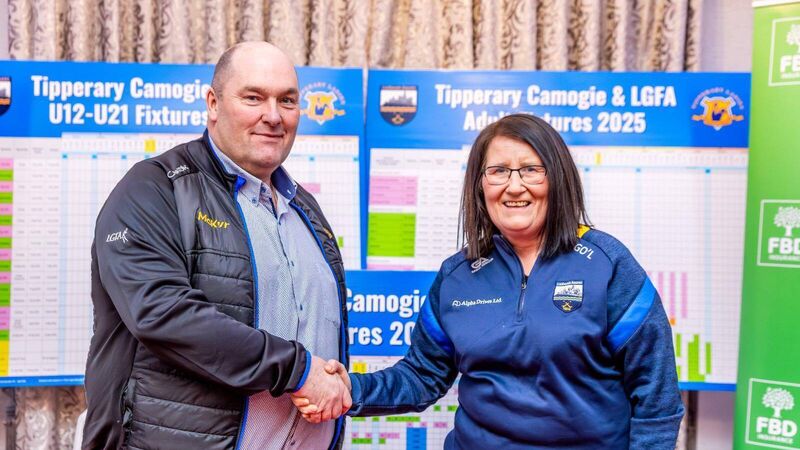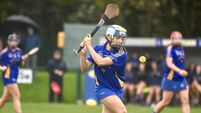Tipperary's unified master fixture plan is first of its kind

BABY STEPS: Damian Johnston (Tipperary Ladies Football Chairperson) and Grainne O'Leary (Tipperary Camogie Chairperson).
Joined-up thinking. Or, in other words, common sense. What’s obvious is not always acted upon. Especially in the world of Gaelic games.
This Sunday, for example, the Cork footballers are in Inniskeen for a 1.30pm throw-in against Monaghan. At 2pm, just over the road in Castleblayney, the Cork ladies footballers will also line out against the locals in Round 4 of their respective League.
Now, maybe there was no pitch in such rude February health as to be capable of hosting a double-header, but you see how it looks that two Cork football teams are making the long journey to Monaghan on the same afternoon, only to line out at the same time in venues 20 minutes apart.
Joined-up thinking. The penny has dropped in Tipperary. The hope is that their pioneering actions will cause the penny to drop for others too.
Over the weekend, the Tipperary camogie and ladies football county boards unveiled a single master fixture plan for 2025. The historic move showcased the determination of both administrations to put the player first, rather than the code they represent.
The collaborative effort to align fixtures is aimed at minimising clashes and ending the wholly unnecessary practice of dual players having to pick one code over the other because of scheduling conflicts.
Tipperary’s 2025 unified fixture schedule runs from senior right the way down to U12, and will be subject to a live review throughout the year so as to deal with any and all issues as they arise.
At underage and adult level, ‘play by’ dates have been introduced for the earlier rounds of competitions.
“The ‘play by’ date might be a Tuesday for U14 camogie and Thursday for U14 ladies football. It allows for flexibility of the fixture and it allows players to play both codes,” explained Tipperary camogie PRO Ger Kinane.
For the adult county championships, there will be a maximum of three weekends where both codes are in action. And it has already been thrashed out that camogie will take one day, ladies football the other. Beyond that, the calendar will be camogie one weekend, ladies football the next.
“It is not going to be perfect and there will be occasions where players have to play two games on one weekend. But against that, they will have their ‘play by’ dates, so they could try and shift one of them to midweek, as opposed to playing both games on the same weekend. At all times, though, both codes will be aware of what the other is doing,” Kinane continued.
The joint-master fixture plan has been led by the newly elected chairpersons of both county boards, Damian Johnston on the football side and Grainne O’Leary in the camogie corner. Equally important in reaching hands across the divide and delivering this combined schedule are respective fixture secretaries, also new into their roles, Paddy Caplice (camogie) and Mairead Tarrant (ladies football).
Tipperary’s joined-up thinking is a significant departure from 2020 when Cahir pulled out of the Tipp Junior A camogie final because of the player welfare issues involved in the majority of their players featuring in the following day’s senior football decider.
“There is a strive here to ensure a choice does not have to be made. No more ‘I can't play ladies football on Sunday because I have to play camogie’, or vice-versa. The player's right to choose both codes is there for them,” said Tipp ladies football PRO Martin Grey.
“This schedule isn’t 100% perfect. But it is a start, a massive start because both fixture committees are talking to each other. We were all guilty of saying our code comes first, this was our day first. That attitude has changed.
“No more than any dual county, this county has people who want to put a pin in every football and others who want to break every hurley in the county. Thankfully, we are moving past that archaic, grey-haired attitude.”
On the road to integration, Tipperary have shown that while top-brass thrash out the headline issues, such local enterprise can also help move the whole process along.
“This is a small baby step, but it may yet prove to be monumental,” said Grey.
“I'm very excited about integration and I'd like to see more debate about it at the top, but everyone has to do their bit on the ground as well,” added Kinane.
“This is the most simple and basic step, but probably the most important one as it shows communication and cooperation between the two county boards. And there can't be any integration unless people are willing to work together, listen to each other, and come up with solutions together. It makes so much sense and this is the way it is going to be going forward.”














